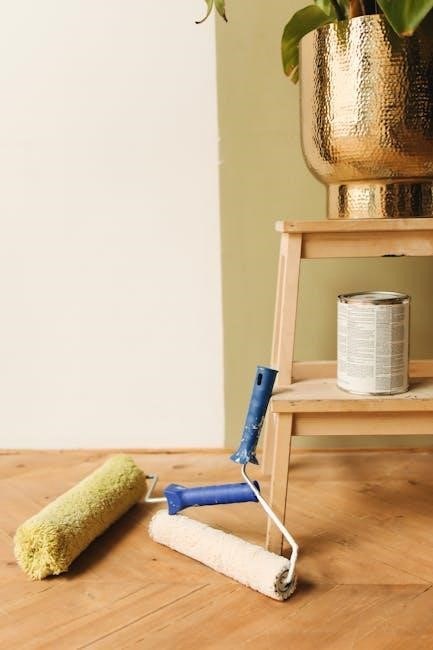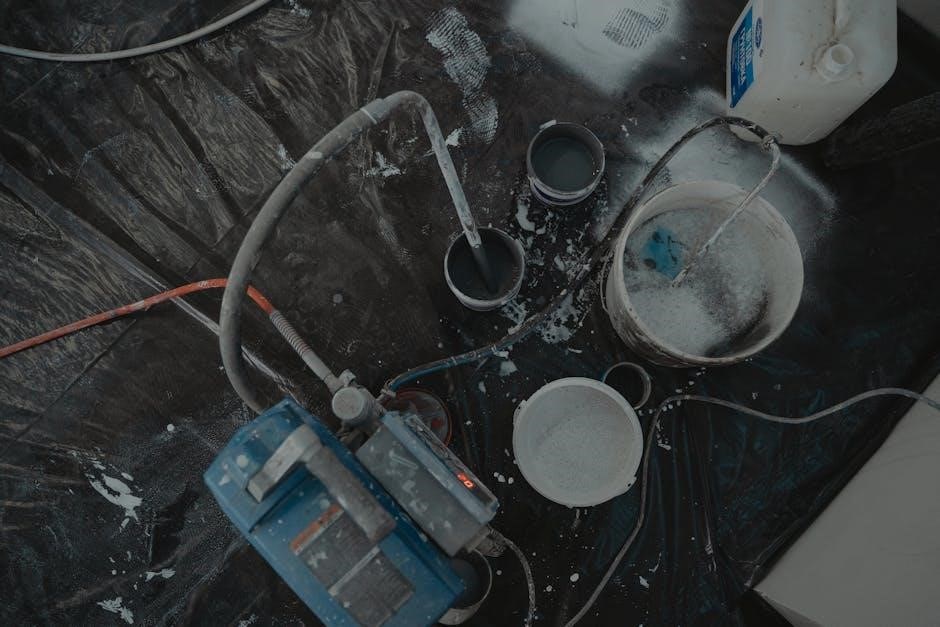A house maintenance checklist is a detailed guide helping homeowners track essential tasks, from seasonal preparations to appliance care․ Customizable and printable, it ensures timely upkeep and prevents costly repairs․

Why a House Maintenance Checklist is Essential
A house maintenance checklist is crucial for preventing costly repairs, ensuring safety, and extending the lifespan of your home․ It helps organize tasks, avoiding overlooked issues like leaks or worn-out systems․ Regular upkeep enhances comfort, energy efficiency, and property value․ By scheduling inspections and repairs, you avoid unexpected failures, such as a malfunctioning HVAC system or plumbing leaks․ A checklist also provides peace of mind, knowing your home is secure and well-maintained․ Whether you’re a new homeowner or a seasoned one, a detailed checklist ensures nothing is missed, making it an indispensable tool for responsible home ownership․
How to Create a Comprehensive House Maintenance Checklist
Creating a comprehensive house maintenance checklist involves categorizing tasks by frequency and area․ Start by listing monthly, seasonal, and annual tasks, such as gutter cleaning or HVAC inspections․ Include both interior and exterior areas, like roofs, walls, and appliances․ Use a printable PDF template or a digital tool to organize tasks, ensuring clarity and ease of use․ Customize the checklist to suit your home’s specific needs, such as adding seasonal tasks for extreme climates․ Regularly review and update the list to keep it relevant and effective, ensuring all aspects of your home are covered for optimal maintenance and longevity․
The Benefits of Regular Home Maintenance
Regular home maintenance offers numerous benefits, including preventing costly repairs, enhancing safety, and boosting property value․ It ensures systems function efficiently, reducing energy bills and extending appliance lifespans․ By addressing issues early, you avoid larger problems and maintain a comfortable living environment․ Regular upkeep also reduces the risk of accidents, such as electrical fires or plumbing leaks․ Additionally, consistent maintenance improves air quality and overall home durability․ A well-maintained home not only saves money but also provides peace of mind, knowing your space is secure and functional for years to come․

Exterior Home Maintenance
Regular exterior checks prevent damage and ensure your home’s longevity․ Inspect walls, windows, and doors while cleaning gutters to maintain structural integrity and functionality․
Roof Inspection and Maintenance
Regular roof inspections are crucial to identify leaks, damaged shingles, and structural weaknesses․ Clean gutters and downspouts to ensure proper water drainage, preventing ice buildup and potential damage․ Inspect roof flashing around chimneys and vents for gaps or wear․ Replace missing or loose shingles promptly to avoid water infiltration․ Check for signs of mold, rot, or sagging, which may indicate underlying issues․ Ensure downspouts drain at least 4 feet away from the house to protect foundations․ Professional inspections are recommended annually or after severe weather to maintain your roof’s integrity and extend its lifespan․
Gutter and Downspout Cleaning
Clean gutters and downspouts regularly to ensure proper water flow and protect your home’s foundation․ Remove leaves, debris, and sediment that can cause clogs and overflow․ Flush gutters with water to check for blockages and ensure downspouts drain efficiently․ Install gutter guards to minimize future maintenance․ Inspect for sagging or loose sections and secure them․ Ensure downspouts extend at least 4 feet away from the house to prevent water pooling․ Schedule cleaning twice a year, especially after fall and spring, to maintain your home’s exterior integrity and prevent costly repairs from water damage․
Wall and Siding Inspection
Regularly inspect walls and siding for cracks, gaps, or damage to ensure structural integrity․ Use a checklist to note areas needing repair․ Check for peeling or fading paint, which may indicate water damage or wear․ Look for signs of mold, mildew, or rot, especially near windows and doors․ Inspect for loose or missing siding panels and secure them promptly․ Ensure caulking around joints and seams is intact and reseal if necessary․ Addressing these issues early prevents costly repairs and maintains your home’s curb appeal and protection against the elements․
Window and Door Maintenance
Check windows and doors for air or water leaks, cracks, or warped frames․ Lubricate hinges and ensure proper sealing to prevent energy loss․ Clean sills and tracks, and replace worn weatherstripping․ Inspect glass for damage and replace broken panes․ Test door and window locks for functionality․ Re-paint or re-stain as needed to protect surfaces․ Addressing these issues maintains energy efficiency, security, and appearance․ Regular maintenance prevents costly repairs and ensures smooth operation of all moving parts․ Use a checklist to track these tasks and keep your home secure and weather-tight year-round․

Interior Home Maintenance
Inspect floors, walls, and ceilings for damage or moisture․ Check for mold in basements or crawl spaces․ Ensure proper insulation and ventilation for energy efficiency and air quality․
Floor Inspection and Cleaning
Regularly inspect floors for cracks, dents, or water damage․ Clean surfaces according to material—vacuum carpets, mop hardwood, and scrub tiles․ Address spills immediately to prevent stains․ Check for loose boards or tiles and secure them․ Use appropriate cleaning products to maintain appearance and durability․ Schedule deep cleaning sessions seasonally to tackle embedded dirt․ For carpets, consider professional steam cleaning annually․ Inspect under rugs for moisture or mold․ Ensure all floor areas are clear of clutter to prevent tripping hazards․ Keep high-traffic zones clean to extend lifespan and maintain a polished look․
Wall and Ceiling Checks
Inspect walls and ceilings for cracks, peeling paint, or water stains, which may indicate structural issues or leaks․ Check for mold or mildew growth, especially in areas prone to moisture․ Clean surfaces with mild detergents to maintain appearance and hygiene․ Ensure caulking around windows and doors is intact to prevent air leaks or water seepage․ Look for signs of pest damage, such as holes or nests․ Test for loose wallpaper or plaster and repair as needed․ Regular inspections help prevent costly repairs and ensure a safe, stable living environment․ Schedule checks annually or after extreme weather conditions․
Insulation and Ventilation
Check insulation in attics, walls, and crawl spaces to ensure it meets local energy codes and remains intact․ Inspect for signs of moisture, mold, or pest damage․ Verify that vents in attics, bathrooms, and kitchens are functioning properly to maintain airflow and prevent humidity buildup․ Clean or replace air filters in HVAC systems to improve air quality and efficiency․ Look for gaps or leaks in ductwork and seal them if necessary․ Proper insulation and ventilation help reduce energy costs, prevent moisture damage, and maintain a healthy indoor environment․ Schedule professional inspections if you notice issues like uneven heating or cooling․
Appliances and Systems Maintenance
Regularly inspect HVAC systems, plumbing, and electrical components for leaks or damage․ Clean filters, check appliance manuals, and ensure proper functionality to prevent breakdowns and extend lifespan․
Kitchen Appliances
Inspect and maintain kitchen appliances regularly to ensure efficiency and longevity․ Clean ovens, ranges, and refrigerators to remove grease and food residue․ Check dishwashers and microwaves for proper function and hygiene․ Replace worn-out seals and inspect for leaks․ Ensure all appliances are properly vented to avoid moisture buildup․ Regularly descale water-using appliances like ice makers and coffee machines․ Calibrate oven temperatures as per the manufacturer’s instructions․ Schedule professional maintenance for complex systems․ Keep user manuals handy for troubleshooting and maintenance guidance․ Addressing issues early prevents costly repairs and keeps your kitchen running smoothly year-round․
Plumbing System
Regular plumbing checks are crucial to prevent leaks, water damage, and system failures․ Inspect under sinks, around toilets, and near appliances for signs of moisture or leaks․ Check hoses connected to washing machines and dishwashers for cracks or wear․ Ensure proper drainage by running water through rarely used drains․ Clean garbage disposals and check water pressure in faucets․ Inspect the water heater for leaks or rust and adjust temperature settings as needed․ Flush sediment from the tank annually․ Check outdoor faucets for proper winterization and inspect septic systems if applicable․ Address any issues promptly to avoid costly repairs and maintain efficient water flow throughout your home․
Heating and Cooling Systems
Regular maintenance of heating and cooling systems ensures efficiency, safety, and longevity․ Change air filters monthly to improve air quality and reduce energy costs․ Inspect thermostat settings and calibrate if necessary․ Check ductwork for leaks or damage and seal gaps with duct tape or mastic․ Clear debris from outdoor units to ensure proper airflow․ Drain condensate lines for AC units to prevent water damage․ Schedule annual professional inspections for furnace and AC tune-ups․ Ensure proper ventilation in attics and basements to maintain balanced system performance․ Address any unusual noises or drops in performance promptly to avoid costly repairs and ensure consistent comfort year-round․
Electrical System
Regularly inspect your home’s electrical system to ensure safety and functionality․ Check circuit breakers and fuses for tripped switches or blown fuses․ Inspect outlets and switches for damage or wear․ Ensure all electrical cords and appliances operate properly without fraying or overheating․ Test Ground Fault Circuit Interrupter (GFCI) outlets monthly by pressing the “test” button․ Replace light bulbs with the correct wattage specified by fixtures․ Look for flickering lights or warm outlets, which may indicate issues․ Avoid overloading circuits with too many devices․ Schedule a professional inspection if you notice any electrical issues or outdated systems to prevent hazards and ensure compliance with safety standards․

Seasonal Maintenance Tasks
Seasonal maintenance ensures your home is prepared for changing weather conditions․ Tasks include cleaning gutters, inspecting roofs, and servicing HVAC systems to optimize efficiency and safety year-round․
Spring Maintenance
Spring maintenance is crucial for preparing your home after winter․ Start by cleaning gutters and downspouts to ensure proper water flow․ Inspect the roof for damaged or missing shingles and check for signs of leaks․ Trim tree branches and shrubs to prevent damage to siding and windows․ Power wash exterior surfaces to remove dirt and mildew․ Check and repair porch flooring, steps, and railings․ Inspect window sills and door thresholds for cracks or rot․ Ensure the sump pump and floor drain are functioning properly․ Don’t forget to calibrate your oven temperature and lubricate door hinges for smooth operation․

Summer Maintenance
Summer maintenance focuses on preparing your home for warmer weather and outdoor activities․ Inspect your roof for damage from spring storms and ensure gutters are clean․ Check HVAC systems to ensure proper cooling and replace air filters․ Wash windows and window screens to improve visibility and airflow․ Inspect outdoor lighting and replace bulbs as needed․ Clean patio furniture and grill areas for outdoor entertaining․ Trim shrubs and trees to maintain curb appeal․ Check for signs of pests or rodent infestations․ Inspect sprinkler systems for proper function and water efficiency․ Ensure proper ventilation in attics and crawl spaces to prevent overheating․
Fall Maintenance
Fall maintenance is crucial for preparing your home for colder months․ Clean gutters and downspouts to ensure proper water flow and inspect roofs for leaks or damaged shingles․ Check insulation in attics and crawl spaces to retain heat․ Seal drafts around windows and doors with weatherstripping or caulk․ Inspect HVAC systems to ensure they are ready for winter․ Clean outdoor furniture and store it securely․ Trim tree branches near the house to avoid damage from heavy snow․ Inspect plumbing for leaks or frozen pipe risks․ Prepare your garden by cleaning up debris and protecting plants from frost․ Ensure proper ventilation to prevent moisture buildup and mold growth․
Winter Maintenance
Winter maintenance ensures your home remains safe and efficient during the coldest months․ Insulate exposed pipes in unheated areas like the garage or basement to prevent freezing․ Drain and store hoses, and install freeze-proof faucets․ Check your heating system for proper function and change air filters․ Inspect windows and doors for air leaks, sealing gaps with weatherstripping or caulk․ Clear gutters of debris to allow ice to melt properly․ Trim tree branches near the house to prevent snow-related damage․ Ensure the fireplace and chimney are clean and functioning safely․ Stock up on salt or sand for icy walkways and have a snow shovel ready․ Maintain proper ventilation to prevent condensation and mold growth․ Keep emergency supplies like flashlights and batteries on hand in case of power outages․ Regularly check the condition of your roof for snow accumulation or ice dams, which can cause structural damage․ Ensure all outdoor lighting is functional to improve visibility during darker winter months․ By following these steps, you can protect your home from winter’s harsh conditions and ensure a warm, safe living environment․ Stay proactive to avoid costly repairs and maintain your home’s value․ Proper winter maintenance also helps reduce energy bills by keeping your home well-insulated and draft-free․ Stay organized with a printable winter maintenance checklist to keep track of all necessary tasks and ensure nothing is overlooked․ This way, you can enjoy the beauty of winter without worrying about potential issues arising from neglect․ Regular inspections and timely repairs are key to a stress-free winter season․ Don’t forget to check your emergency kit and ensure it’s fully stocked with essentials like blankets, a first aid kit, and a battery-powered radio․ Stay safe and warm this winter with a well-maintained home․ The effort you put into winter maintenance will pay off in the long run, saving you time and money while keeping your home in great condition․ Always prioritize safety when performing outdoor tasks, especially when dealing with heavy snow or icy surfaces․ Consider hiring professionals for tasks like chimney cleaning or roof inspections if you’re unsure․ A well-prepared home not only withstands the rigors of winter but also provides a comfortable and cozy space for you and your family․ Make winter maintenance a priority to enjoy peace of mind throughout the season․ Ensure all carbon monoxide detectors are functioning correctly to protect your family’s health․ Keep your garage door sealed tightly to prevent cold air from entering and to protect your vehicles․ Check the condition of your siding and repair any damage to prevent moisture from seeping in․ By following a comprehensive winter maintenance checklist, you can address all critical areas and safeguard your home against the challenges of the season․ Stay ahead of potential issues and enjoy a stress-free winter with a well-maintained home․ Remember, prevention is key to avoiding costly and time-consuming repairs down the line․ Stay warm and safe this winter by taking care of your home now․ A little effort goes a long way in preserving your home’s integrity and ensuring it remains a comfortable haven all year round․
Regular home maintenance is crucial for preserving your property’s value and ensuring safety․ By following a comprehensive checklist, you can address issues before they escalate․ Prioritize seasonal tasks and customize your checklist to suit your home’s needs․ Stay organized with printable PDF guides and review them annually to adapt to changing requirements․ Remember, consistent effort prevents costly repairs․ Keep emergency supplies handy and inspect systems like plumbing and electrical regularly․ Maintain proper ventilation and insulation to save energy․ Finally, don’t hesitate to seek professional help for complex tasks․ A well-maintained home is a safe and comfortable haven, reflecting your dedication to its care․